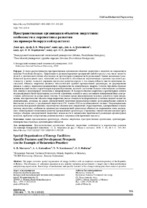Пространственная организация объектов энергетики: особенности и перспективы развития (на примере белорусской практики)

Date
2020Publisher
Another Title
Spatial Organization of Energy Facilities: Specific Features and Development Prospects (on the Example of Belarusian Practice)
Bibliographic entry
Пространственная организация объектов энергетики: особенности и перспективы развития (на примере белорусской практики) = Spatial Organization of Energy Facilities: Specific Features and Development Prospects (on the Example of Belarusian Practice) / Е. Б. Морозова [и др.] // Наука и техника. – 2020. – № 3. – С. 195-203.
Abstract
В статье рассматривается пространственная организация объектов энергетики с акцентом на современную практику Республики Беларусь. Эффективность функционирования предприятий любой отрасли, в том числе энергетической, в значительной степени обусловлена их архитектурно-планировочной организацией. Знание механизмов и особенностей происходящих здесь изменений дает возможность обосновывать перспективную стратегию проектной деятельности, а значит, позволяет управлять процессами развития отрасли и тем самым избежать многих негативных последствий. Объекты энергетики являются типологической группой промышленной архитектуры, их формирование началось в связи с переходом промышленного производства на электрическую энергию. Сегодня типология отражает функциональный подход в архитектурном формообразовании, включает достаточно большое многообразие составляющих единиц и демонстрирует тенденцию к диверсификации. В Беларуси объекты энергетики в архитектурном аспекте их классификации были представлены достаточно ограничено, основную массу составляли теплофикационные электростанции, работающие на разных видах топлива. В настоящее время диверсификация получила развитие в таких направлениях, как строительство объектов гидроэнергетики (малые станции на водохранилищах и станции средней мощности, низконапорные, русловые, на реках), альтернативной энергетики (ветроэлектростанции, фотоэлектрические станции и биогазовые установки) и традиционной энергетики (ТЭС и мини-ТЭЦ на возобновляемом топливе). Охарактеризованы результаты белорусской практики строительства объектов всех направлений (гидроэнергетика, альтернативная и традиционная энергетика), особенности архитектурно-планировочной организации объектов на современном этапе, корреляция с общемировыми тенденциями развития промышленной архитектуры. Определены типологические признаки архитектуры объектов альтернативной энергетики, возможности и направления практической реализации архитектурных подходов, проблемы и перспективы развития научного сопровождения проектного процесса.
Abstract in another language
The paper considers spatial organization of energy facilities with an emphasis on modern practice of the Republic of Belarus. The efficiency of enterprise operation in any industry including power industry is largely due to their architectural and planning organization. Knowledge of mechanisms and specific features of the changes taking place here makes it possible to justify a promising strategy for project activities, and therefore, it allows to manage development processes of the industry and thereby avoid many negative consequences. Energy facilities are a typological unit of industrial architecture, their formation has been started due to transition of industrial production to electric energy. Today the typology shows functional approach in architectural shaping, it includes a fairly large variety of constituent units and demonstrates a tendency towards diversification. In Belarus energy facilities in the architectural aspect of their classification are limited mostly to thermal power plants operating on different types of fuel. Currently the diversification is developing in the following areas: construction of hydropower facilities (small plants on reservoirs, medium power plants, low-pressure plants, run-of-the-river hydraulic power stations), alternative energy (wind power stations, photovoltaic power stations and biogas plants) and conventional energy (thermal power plant, mini-combined heat and power plant operating on renewable fuel). The results of Belarusian practice in construction of all types of facilities (hydropower, alternative and conventional energy), peculiarities of the architectural and planning organization of facilities at the current stage, correlation with global trends in the development of industrial architecture have been characterized in the paper. The paper has determined typological features of alternative energy facility architecture, opportunities and directions for implementation of architectural approaches, problems and prospects to develop scientific support for the project process.
View/
Collections
- № 3[9]
